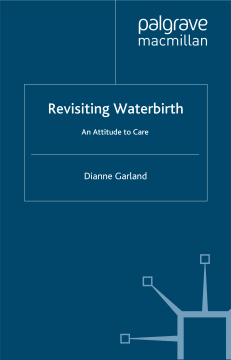
Additional Information
Book Details
Abstract
Revisiting Waterbirth is an essential text for midwifery practice, by an internationally renowned author. This revised version of Garland's previous book Waterbirth gives clear and structured guidance on the use of water in labour, through clinical scenarios, research summaries and evidence-based advice for both students and practitioners.
DIANNE GARLAND is a registered Midwife with over 20 years of experience, who has successfully introduced midwifery changes in order to enhance woman centred care. She is committed to the development of midwives' life long education through learning contracts which integrate theory and practice. She has experience of working with a multi-professional team within an NHS trust and with outside agencies.
Revisiting Waterbirth is an essential text for midwifery practice, by an internationally renowned author. This revised version of Garland's previous book Waterbirth gives clear and structured guidance on the use of water in labour, through clinical scenarios, research summaries and evidence-based advice for both students and practitioners.
Table of Contents
| Section Title | Page | Action | Price |
|---|---|---|---|
| Cover | Cover | ||
| Contents | vii | ||
| List of Figures | x | ||
| List of Tables | xi | ||
| List of Boxes | xii | ||
| Foreword | xiii | ||
| Preface | xv | ||
| Abbreviations | xvii | ||
| 1 Professional and Governmental Support | 1 | ||
| Midwifery Supervision | 1 | ||
| Government and Professional Reports | 2 | ||
| 2 Why Water? | 10 | ||
| Hydrotherapy and Waterbirth History | 10 | ||
| Why Water for Labour and Birth? | 14 | ||
| Advantages and Disadvantages of Water in Labour | 16 | ||
| 3 Accentuating Normality | 29 | ||
| Midwifery or Medical Model of Care | 29 | ||
| Criteria for Use of Water for High-risk Mothers | 31 | ||
| Criteria Risk Assessment | 38 | ||
| Guidelines for Practice | 42 | ||
| Reviewing Routine Care | 46 | ||
| Relearning Traditional Skills | 49 | ||
| Challenges to Practice | 53 | ||
| 4 Theories of Hydrotherapy in Labour | 56 | ||
| The Effects of Hormones in Labour | 57 | ||
| Normal Adaptive Process | 59 | ||
| Theory 1: Psychological | 61 | ||
| Theory 2: Spiritual | 61 | ||
| Theory 3: Hormonal | 62 | ||
| Theory 4: Physiological | 63 | ||
| Enhancing the Qualities of Water | 64 | ||
| 5 Engaging with Parents | 66 | ||
| Choosing a Pool | 66 | ||
| Parent Information | 67 | ||
| Aquanatal Preparation | 69 | ||
| 6 Robust Clinical Care | 75 | ||
| Family-centred Care | 75 | ||
| Maternal and Newborn Care | 76 | ||
| Assessing Labour | 82 | ||
| Second Stage | 85 | ||
| Third Stage Management: Active versus Physiological | 89 | ||
| Third Stage Options Following a Waterbirth | 90 | ||
| 'What if … ?' | 93 | ||
| 7 Breathing | 105 | ||
| In Utero Consciousness | 105 | ||
| Effects of Hormones | 106 | ||
| Fetal Heat Adaptation | 106 | ||
| Fetal Perspective on Waterbirth | 107 | ||
| Fetal Protection against Inhalation of Water | 108 | ||
| Initiation of the First Breath | 112 | ||
| Apgar Scoring after Waterbirth | 116 | ||
| Benefits of Waterbirth to the Baby | 120 | ||
| 'What if … ?' The Fetal Perspective | 123 | ||
| 8 Interprofessional Issues in Waterbirth | 130 | ||
| Supervisor of Midwives | 130 | ||
| Infection Control | 131 | ||
| Moving and Handling | 133 | ||
| Risk Management | 135 | ||
| Clinical Governance | 137 | ||
| Setting Up a Waterbirth Service | 137 | ||
| 9 Research | 143 | ||
| Audit | 144 | ||
| Some Early Studies | 151 | ||
| The Newborn Perspective | 161 | ||
| Psychological Aspects of Water | 161 | ||
| Expanding Parameters | 163 | ||
| Conclusion | 165 | ||
| 10 Teaching and Ongoing Education | 167 | ||
| Learning from Each Other | 167 | ||
| Literature Review | 182 | ||
| Newsletters | 183 | ||
| Skills Drills | 183 | ||
| Competencies | 183 | ||
| Internet Alerts | 184 | ||
| Videos/DVDs | 184 | ||
| Reflective Practice | 184 | ||
| Professional Visits | 185 | ||
| Midwifery Quiz | 187 | ||
| 11 Help and Further Resources | 190 | ||
| Pool Hire | 190 | ||
| Aquanatal Classes | 191 | ||
| General Information | 191 | ||
| DVDs and Videos | 192 | ||
| Leaflets | 192 | ||
| Concluding Comment | 192 | ||
| Appendix 1: Effects of Adrenaline and Noradrenaline on All Major Systems | 194 | ||
| Appendix 2: Hyperthermia | 195 | ||
| Appendix 3: Temperature Control Pathway for the Fetus in Utero | 198 | ||
| Further Reading | 200 | ||
| References | 202 | ||
| Index | 213 |
